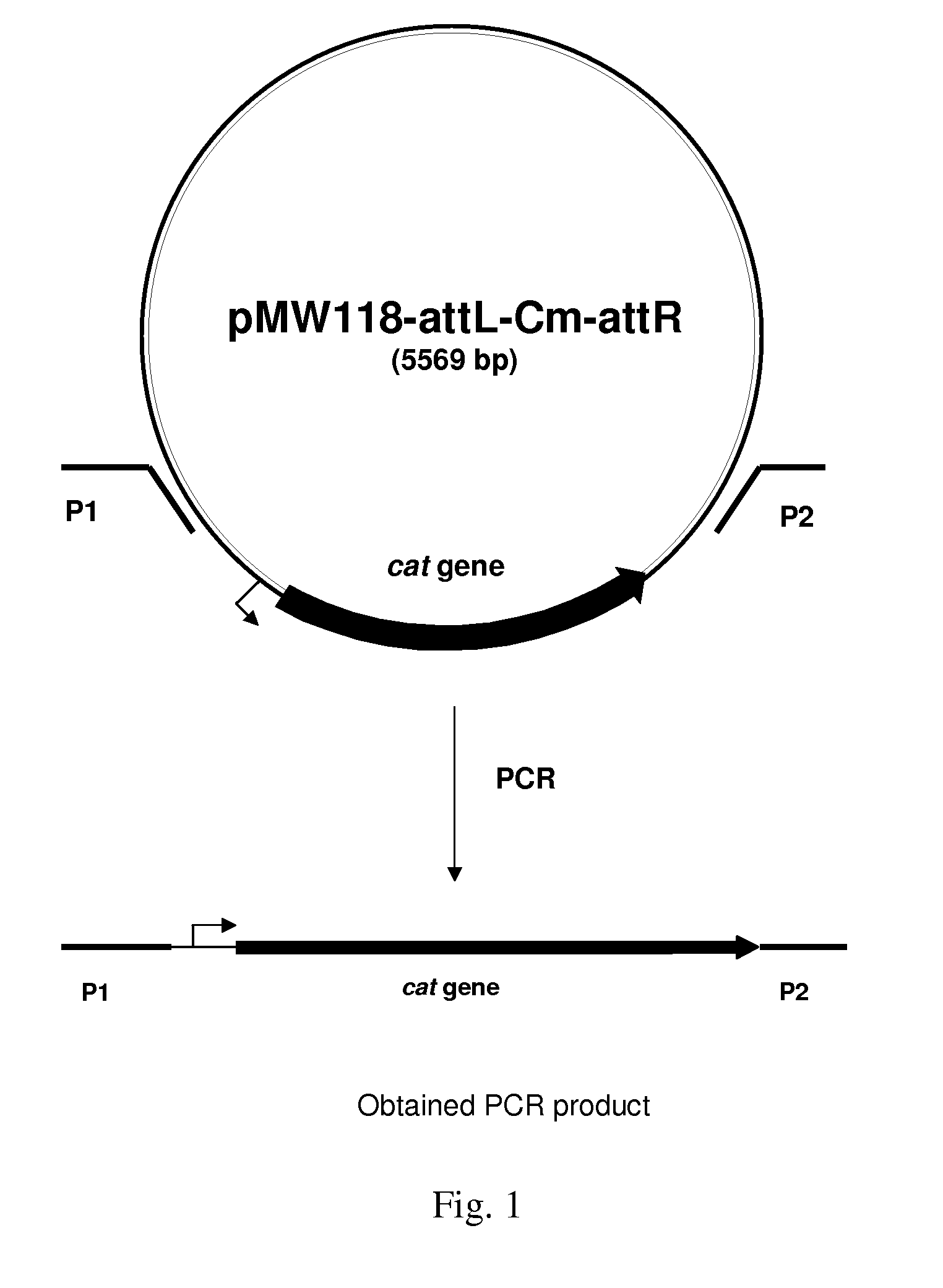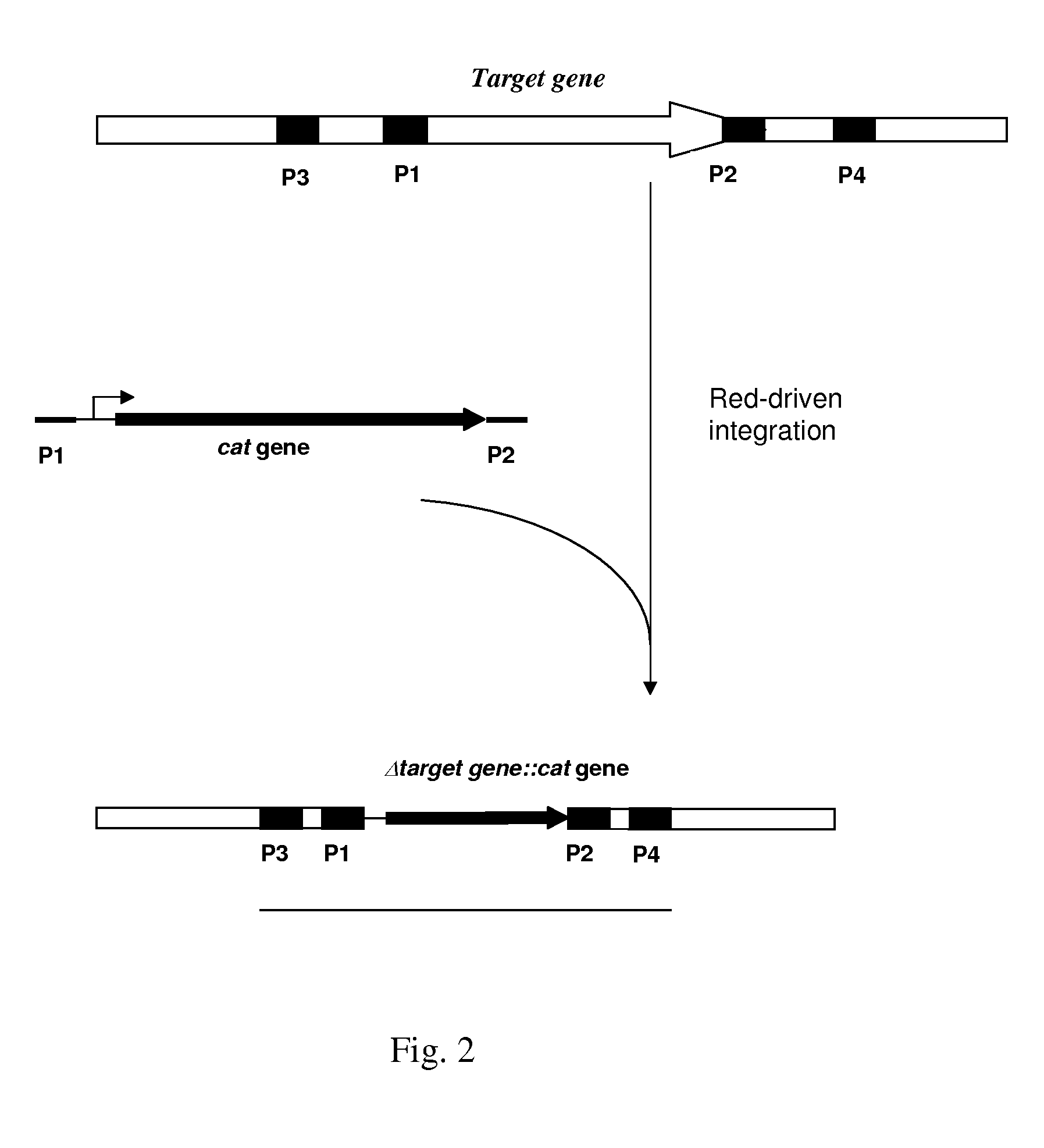Method for producing an L-amino acid using bacterium of the Enterobacteriaceae family with attenuated expression of a gene coding for small RNA
a technology of enterobacteriaceae and l-amino acid, which is applied in the field of microorganisms to achieve the effect of enhancing the productivity of l-amino acid-producing strains
- Summary
- Abstract
- Description
- Claims
- Application Information
AI Technical Summary
Benefits of technology
Problems solved by technology
Method used
Image
Examples
example 1
Construction of a Strain with an Inactivated Gene Coding for sRNA
[0193]1. Deletion of a Target Gene
[0194]A strain having deletion of a gene coding for sRNA can be constructed by the method initially developed by Datsenko, K. A. and Wanner, B. L. (Proc. Natl. Acad. Sci. USA, 2000, 97(12), 6640-6645) called “Red-driven integration”. The DNA fragment containing the CmR marker encoded by the cat gene can be obtained by PCR, using primers P1 (upstream primer) and P2 (downstream primer) and plasmid pMW118-attL-Cm-attR (WO 05 / 010175) as a template. Primer P1 contains both a region complementary to the 35 / 36-nt region located at the 3′ end of a target gene and a region complementary to the attL region in the plasmid pMW118-attL-Cm-attR. Primer P2 contains both a region complementary to the 35 / 36-nt region located at the 5′ end of a target gene and a region complementary to the attR region in the plasmid pMW118-attL-Cm-attR. The nucleotide sequences of the region complementary to the attL re...
example 2
Production of L-Threonine by E. coli Strain Having a Gene Coding for sRNA Deleted
[0204]To test the effect of inactivation of a gene coding for sRNA on threonine production, DNA fragments from the chromosome of the above-described mutant E. coli MG1655 having a gene coding for sRNA (target gene) deleted and marked with the Cm resistance gene can be transferred to the threonine-producing E. coli strain VKPM B-3996 by P1 transduction (Miller, J. H. Experiments in Molecular Genetics, Cold Spring Harbor Lab. Press, 1972, Plainview, N.Y.) to obtain strain B-3996-Δtarget gene. The strain B-3996 was deposited on Nov. 19, 1987 in the All-Union Scientific Center of Antibiotics (Russia, 117105 Moscow, Nagatinskaya Street, 3-A) under the accession number RIA 1867. The strain was also deposited in the Russian National Collection of Industrial Microorganisms (VKPM) (Russia, 117545 Moscow, 1st Dorozhny proezd, 1) on Apr. 7, 1987 under the accession number B-3996. The strains B-3996-Δc0362, B-3996-...
example 3
Production of L-Lysine by E. coli Strain Having a Gene Coding for sRNA Deleted
[0211]To test the effect of inactivation of a gene coding for sRNA on lysine production, DNA fragments from the chromosome of the above-described mutant E. coli MG1655 having a gene coding for sRNA (target gene) deleted and marked with the Cm resistance gene can be transferred to the lysine-producing E. coli strain AJ11442 by P1 transduction (Miller, J. H. Experiments in Molecular Genetics, Cold Spring Harbor Lab. Press, 1972, Plainview, N.Y.) to obtain strain AJ11442-Δtarget gene. AJ11442 strain was deposited at the National Institute of Bioscience and Human-Technology, Agency of Industrial Science and Technology (currently National Institute of Advanced Industrial Science and Technology, International Patent Organism Depositary, Tsukuba Central 6, 1-1, Higashi 1-Chome, Tsukuba-shi, Ibaraki-ken, 305-8566, Japan) on May 1, 1981 and received an accession number of FERM BP-1543. Both E. coli strains, AJ11442...
PUM
| Property | Measurement | Unit |
|---|---|---|
| half life | aaaaa | aaaaa |
| temperature | aaaaa | aaaaa |
| temperature | aaaaa | aaaaa |
Abstract
Description
Claims
Application Information
 Login to View More
Login to View More - R&D
- Intellectual Property
- Life Sciences
- Materials
- Tech Scout
- Unparalleled Data Quality
- Higher Quality Content
- 60% Fewer Hallucinations
Browse by: Latest US Patents, China's latest patents, Technical Efficacy Thesaurus, Application Domain, Technology Topic, Popular Technical Reports.
© 2025 PatSnap. All rights reserved.Legal|Privacy policy|Modern Slavery Act Transparency Statement|Sitemap|About US| Contact US: help@patsnap.com


